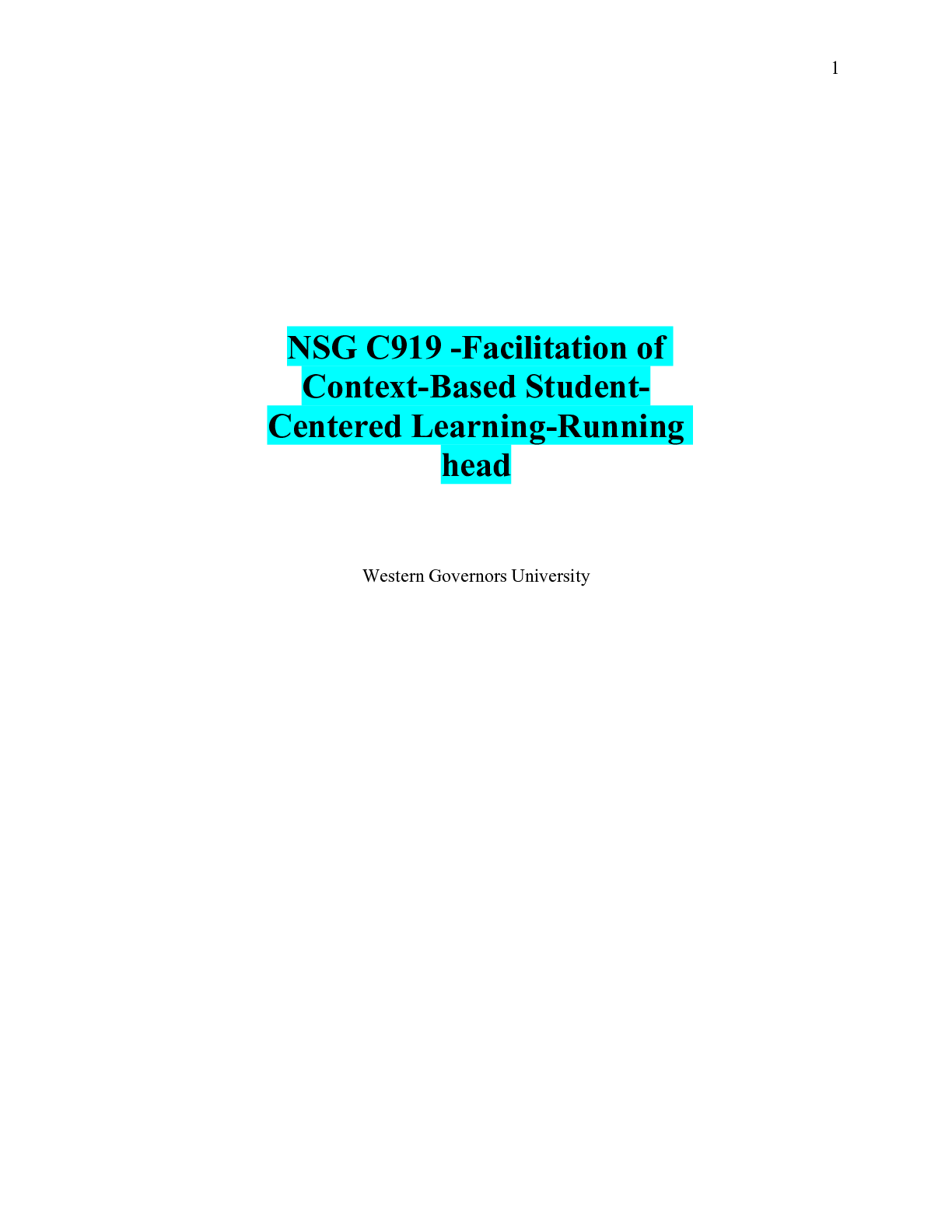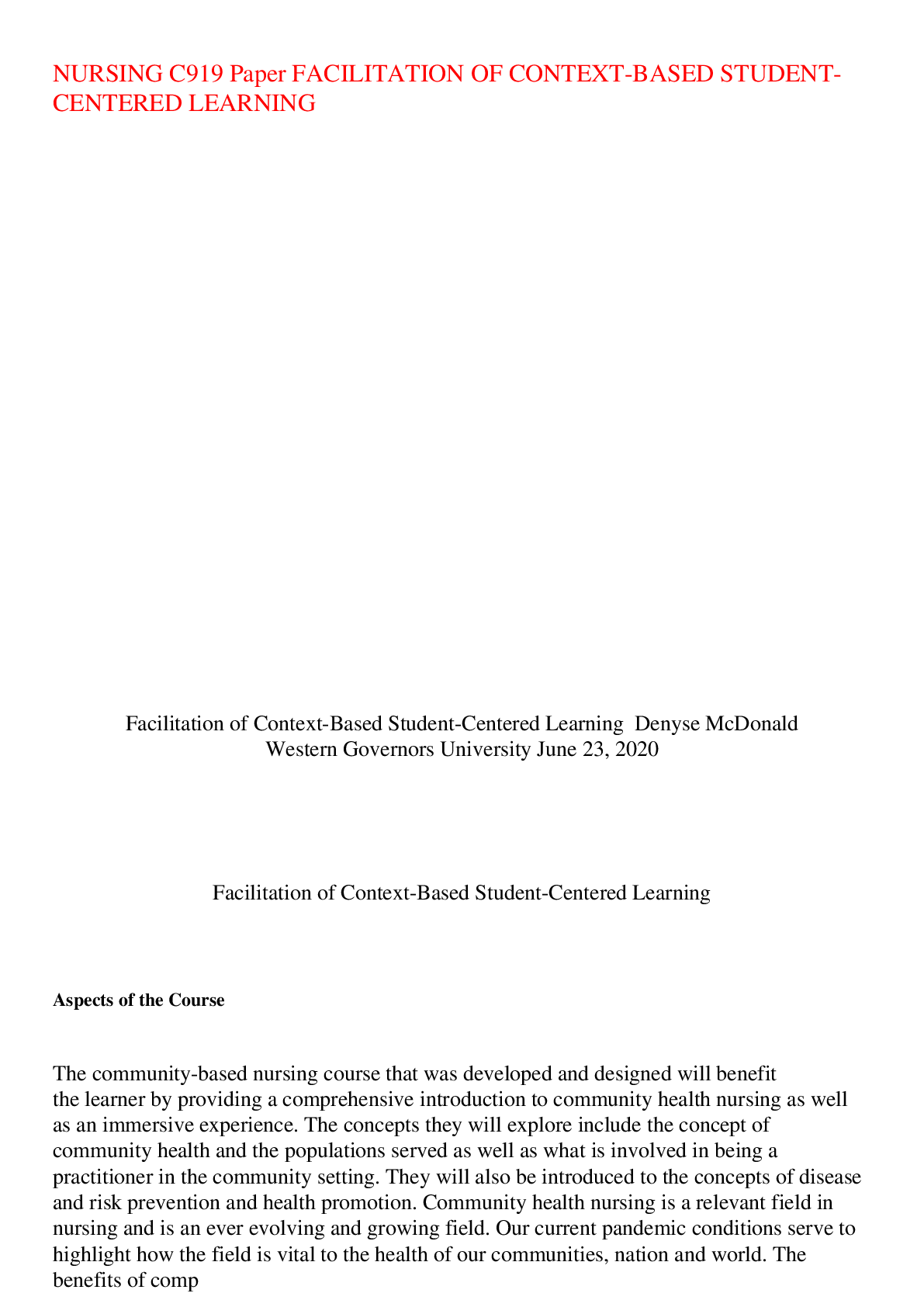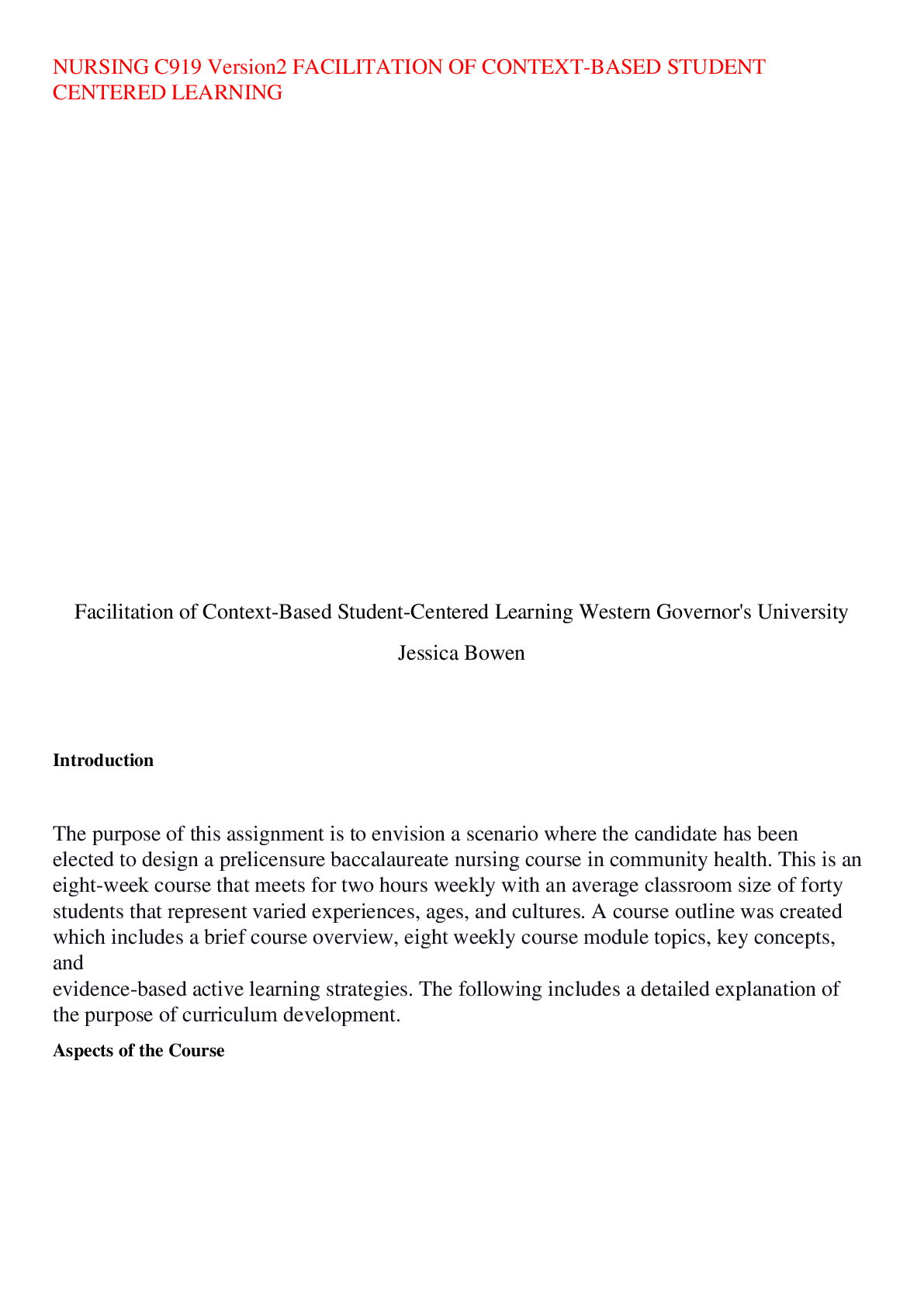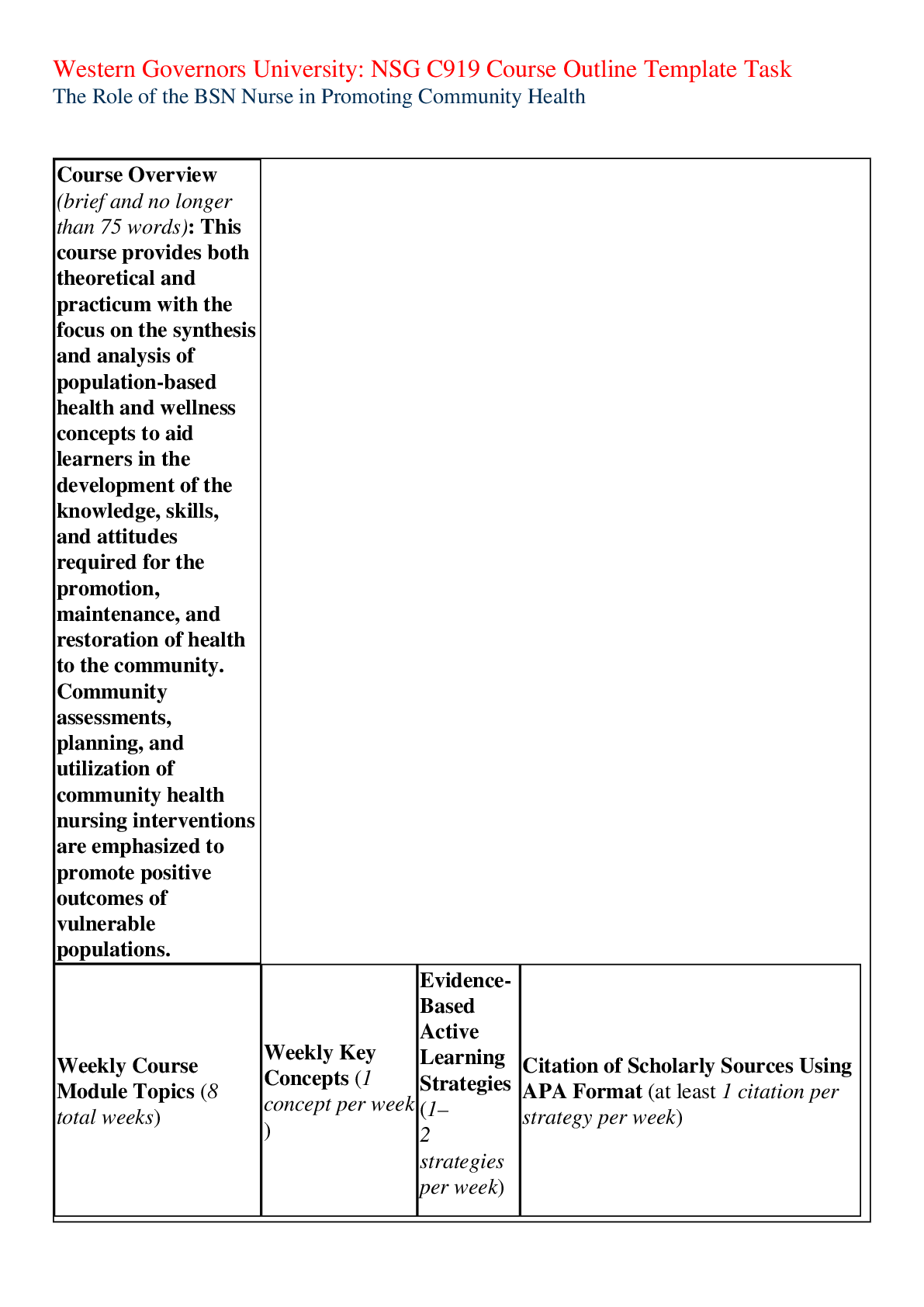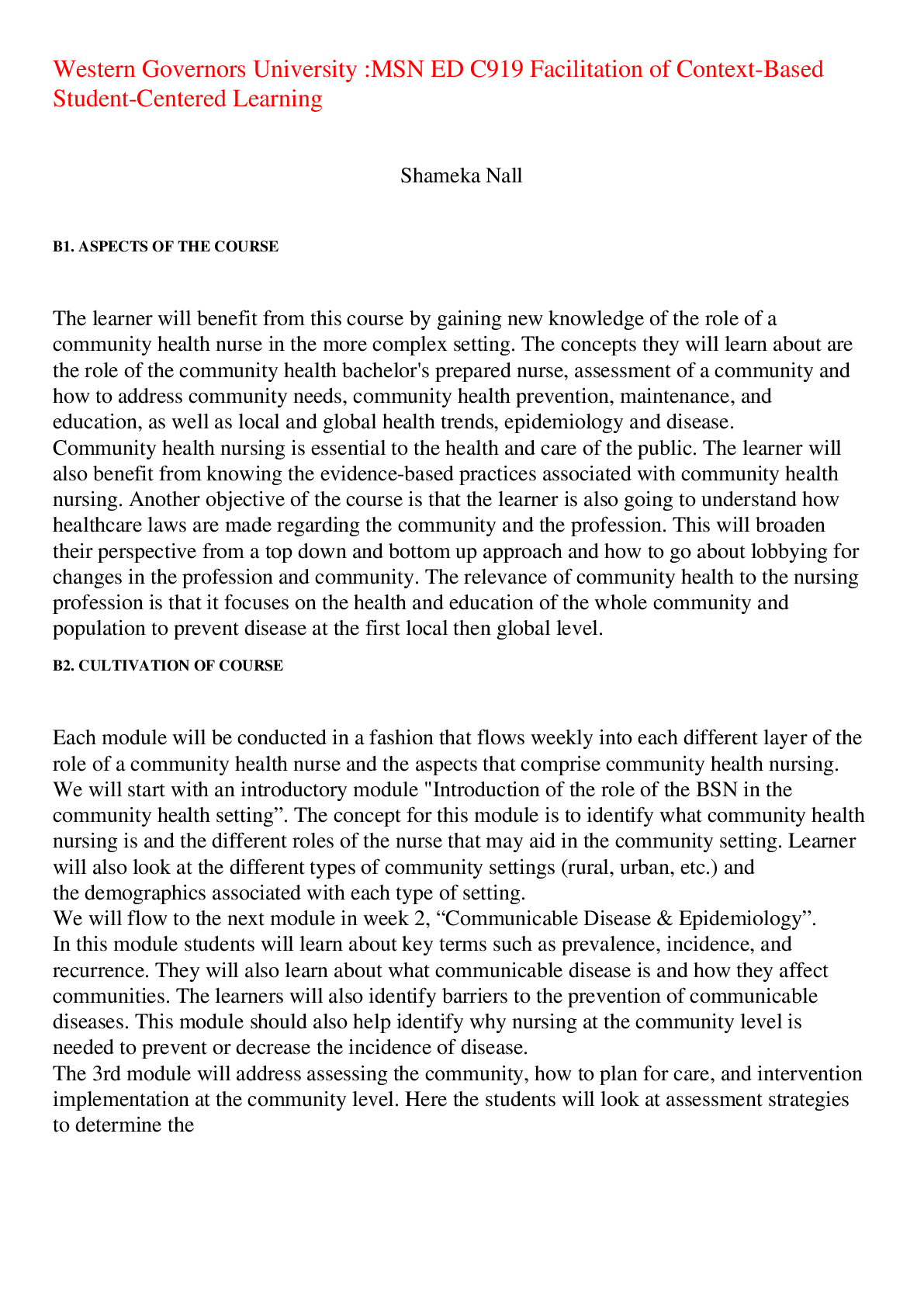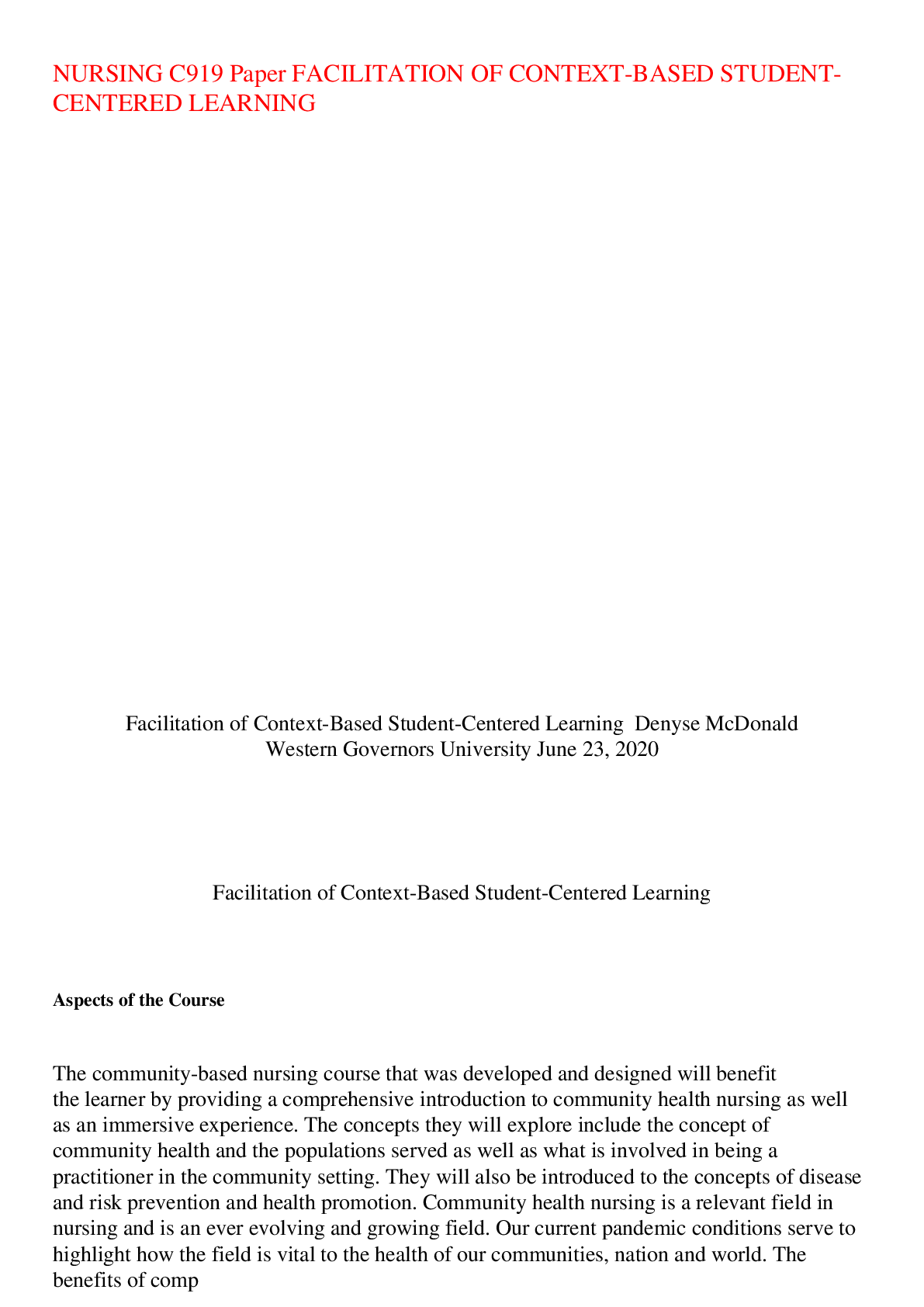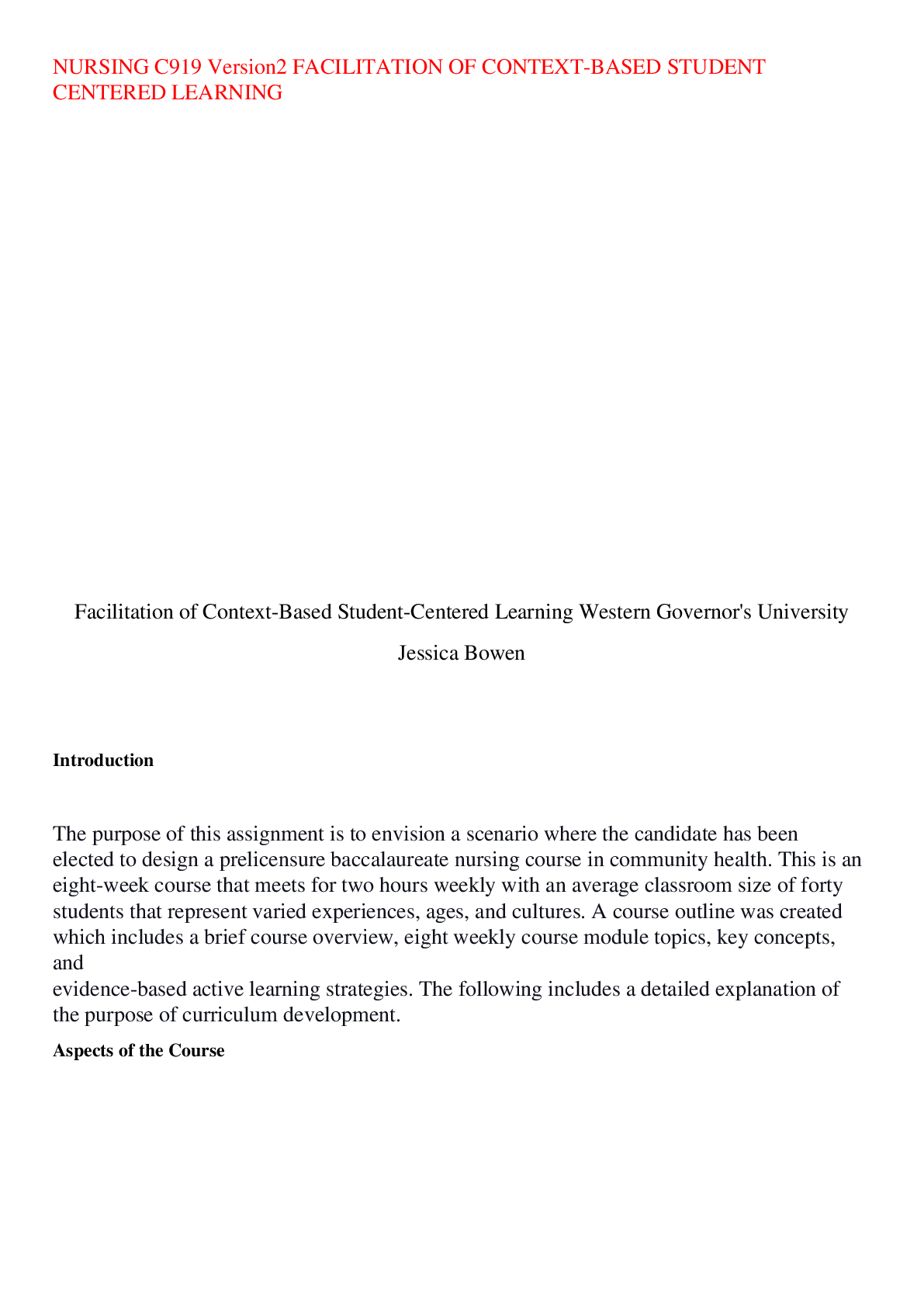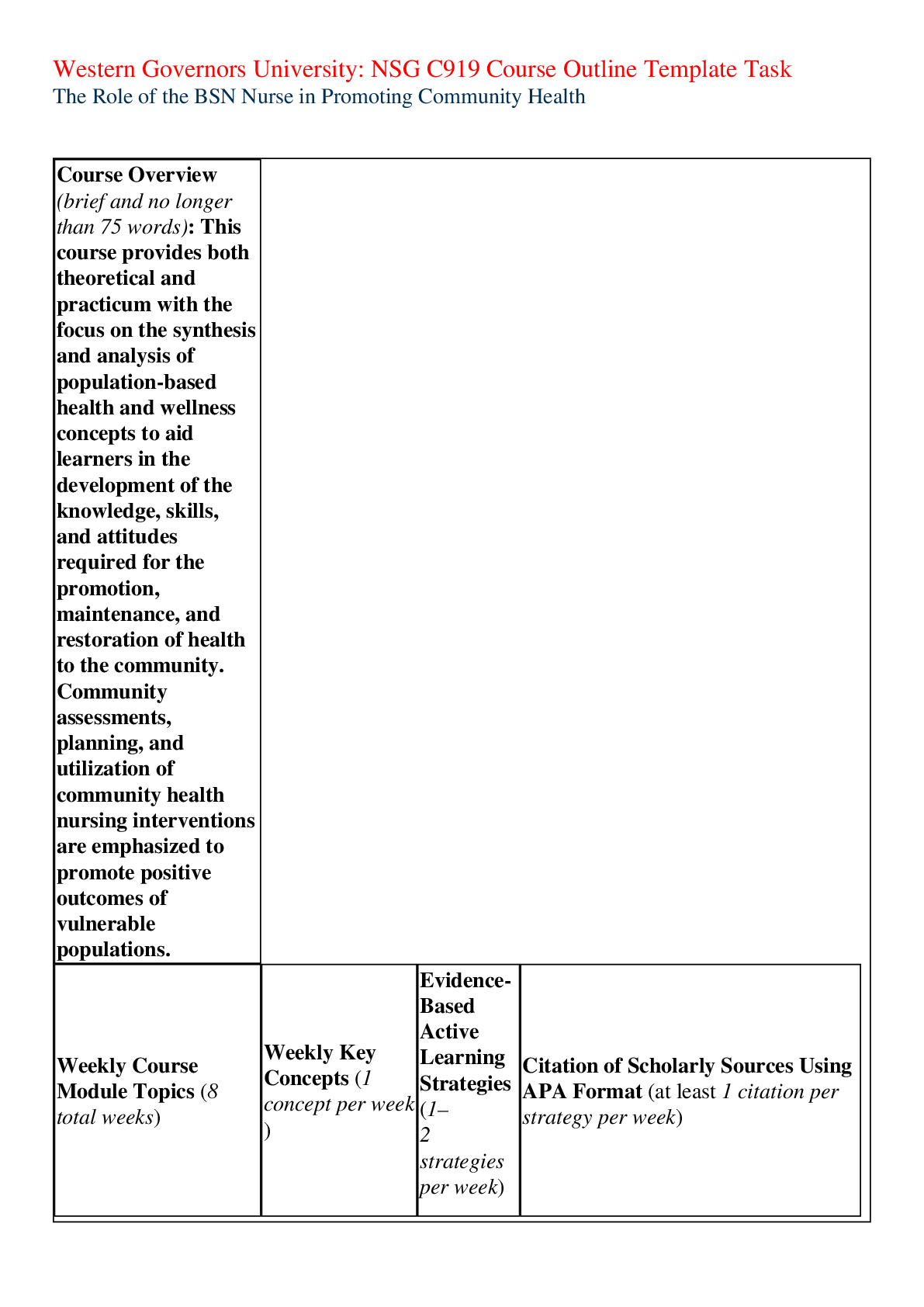*NURSING > EXAM > Western Governors University: NSG C919 Facilitation of Context-Based Student-Centered Learning,100% (All)
Western Governors University: NSG C919 Facilitation of Context-Based Student-Centered Learning,100% CORRECT
Document Content and Description Below
Western Governors University: NSG C919 Facilitation of Context-Based Student-Centered Learning Facilitation of Context-Based Student-Centered Learning Course Overview/Modules Template ... Course Information Aspects of the course The Role of the BSN Nurse in Promoting Community Health is an eight-week course that will benefit the learner by providing both theoretical and practicum, with the focus on the synthesis and analysis of population-based health and wellness concepts. This course is designed to aid learners in the development of the knowledge, skills, and attitudes required for the promotion, maintenance, and restoration of health to vulnerable communities. This course will benefit learners by facilitating a structured learner-centered environment, focus on the promotion of professional development, fostering growth, and strengthening the learners nursing prowess. By keeping class sizes to a maximum of forty learners, the student-faculty relationship can be strengthened, and allows faculty to provide a more supportive environment built on support, effective communication, and wonderful learning experiences! Each week, learners will be immersed in different fun and innovative learning activities based on weekly key concepts relevant to The Role of the BSN Nurse in Promoting Community Health Nursing. Weekly evidence-based modules and key concepts assist learners in developing the knowledge, skills, and attitudes necessary to be a successful Community Health Nurse. Specific concepts include a review of the evolving roles and responsibilities of the community health nurse over time, components of a thorough community health needs assessment and windshield surveys, identifying the necessary health screen needs across the lifespan, discussing the epidemiological processes utilized to improve the health of the community, examination of the causative factors that result in the vulnerability of health in populations, the detrimental impacts of socioeconomic status and health care systems and policy, identifying challenges and healthcare needs of vulnerable populations, analyzing the effects of drugs, alcohol, and violence on vulnerable populations, and finally the community health nurse’s role on the interdisciplinary team and their collaborative role in disaster management programs. The relevance of this course to professional nursing practice stems from the framework set forth by the American Association of Colleges of Nursing (AACN) in the BSN Essentials (2008). The nursing curriculum developed for this course is based on the framework of the AACN in the BSN Essentials, and provides both theoretical and practicum with the focus on the synthesis and analysis of population-based health and wellness concepts to aid learners in the development of the knowledge, skills, and attitudes requires for the promotion, maintenance, and restoration of health to the community. Essential VII, which according to the AACN (2008), is focused on the clinical prevention and population health, where “health promotion and disease prevention at the individual and population level are necessary to improve population health and are important components of baccalaureate generalist nursing practice.” The weekly concepts presented in this course aim to provide learners the with the knowledge, skills, and attitudes required to improve population health through health promotion, disease and injury prevention, and disaster management across the lifespan. The overall objective of this course is to not only prepare the BSN graduate nurse for passing the NCLEX, but for also the transition of a graduate nurse to a competent community health nurse, patient advocate, and an adept partner on the interdisciplinary team. Cultivation of the course In cultivating this course, relevance to nursing practice and development of the learner’s knowledge, skills, and attitudes formed the foundation of this class. Every week, for a total of eight weeks, learners will be introduced to a new course module and concept pertaining to community health nursing. The weekly course modules and concepts are designed to facilitate learning and engagement by building on the previous weeks lesson. Based on course objectives, learners will engage faculty and fellow learners in evidence-based active learning strategies to cultivate learning and encourage the application, synthesis, and analysis of weekly concepts. Week 1 – Introduction to community health. Learners will review and explore the history and evolving roles of the community health nurse over time through collaborative learning. Cultivation of the course will occur through an in-class discussion of the evolving roles and responsibilities of the community health nurse through conversing with their peers to help the development of their own conceptual framework on which to build their autonomous practice as a community health nurse. Week 2 – Community assessment & planning. Learners will apply the nursing process in the community health assessment through concept mapping. Cultivation of the course will occur through the creation of a concept map which builds from their assessment skills from nursing fundamentals to assess, analyze, and synthesize information to carry out a community needs assessment and windshield survey. Week 3 – Promoting health that is population based. Learners will identify the necessary health screen needs across the lifespan. Cultivation of the course will occur through the evidence-based active learning strategy that will be utilized to promote student centered learning is faculty led role-play simulation. For example, high risk behaviors among teens in vulnerable populations at risk of contracting sexually transmitted diseases will be a topic of discussion this week. Learners will determine the ages and developmentally appropriate health promotion and disease prevention activities across the lifespan. Utilizing faculty led role-play simulations allows learners to increase competence and confidence when delivering patient centered care to the vulnerable populations. Week 4 – Epidemiology, communicable diseases, & global health. Learners will discuss, summarize, and understand basic epidemiological concepts utilized in improving community health outcomes, through focusing on contributive factors to emerging and re- emerging diseases amongst vulnerable populations. Cultivation of the course will occur through community service learning. A community service-learning activity will encourage the direct application of theoretical models discussed in class, as such, allow learners to analyze and synthesize course material in a way more meaningful for them. A community service activity can help learners appreciate the community health nursing discipline through an enhanced sense of civic responsibility to the vulnerable communities that we serve. Week 5 – Vulnerable populations, incorporating culture & value. Learners will begin to examine the causative factors that result in the vulnerability of health in populations. Learners will then describe the strategies community health nurses can institute to improve the health status and outcomes of vulnerable populations utilizing a holistic approach. Cultivation of the course will occur through the flipped classroom environment. Utilizing a flipped classroom will allow learners to ascertain the course content and come to class ready to discuss the information they found or engage in teaching the class the portion of the content that they learned. Week 6 – Health care systems & policy. Learners will discuss, compare and contras the role of the state government on healthcare finance and allocated resouces. Learners will then discuss how community health is impacted by socioeconomical status. Cultivation of the course will occur through a case-based case study. Utilizing case studies will allow learners to apply theoretical concepts to real-life situations through the assessment, analysis and syntheses of information to come to a solution to a real-life problem. Week 7 – Health Problems of the Population. Learners will begin to analyze the effects of substance abuse, cultures of violence, communicable diseases and how they impact communities and vulnerable populations. Cultivation of the course will occur through guest speakers with a question and answer portion. Utilizing a question and answer portion of the class will allow learners to participate in discussions with nurses in the community health profession and individuals across the lifespan. Week 8 – Disaster management & community violence. Learners will begin to analyze factors in the community that influence disasters and violence. Learners will then discuss the community health nurse role in the different phases of disaster management and on the disaster team. Cultivation of the course will occur through simulation. Utilizing a simulation is akin to faculty led role-play simulations as, the learners will participate in instructional scenarios to enforce experiential learning. The learner will have an opportunity to practice nursing skills related to disaster management and community violence. Simulations provide learners the opportunity to work in a team and encourage the application of theoretical concepts to real-life situations that community health nurses face. Student centered learning In this course, each weekly module and key concept is presented to the learners using an evidence-based active learning strategy to help develop the learners nursing prowess in the realm of community of health nursing. Course outlines and objectives are learner focused and enforce student-center learning to aid learners in the development of the knowledge, skills, and attitudes required of a community health nurse in order to better serve vulnerable high-risk populations. Many of the weekly concepts in this course promote student-centered learning through the encouragement of student collaboration, group projects, simulations, and student reflections to promote autonomy and independent critical thinking. Week 1 – Introduction to community health. The evidence-based active learning strategy that will be utilized to promote student centered learning is collaborative learning. An in-class discussion of the evolving roles and responsibilities of the community health nurse through conversing with their peers to help the development of their own conceptual framework on which to build their autonomous practice as a community health nurse. Utilizing a collaborative learning strategy requires learners in the class to actively engage with other learners to process, apply, analyze, and synthesize the information, which promotes student- centered learning. Week 2 – Community assessment & planning. The evidence-based active learning strategy that will be utilized to promote student centered learning is concept mapping. Learners will have an opportunity to create a concept map which builds from their assessment skills from nursing fundamentals to assess, analyze, and synthesize information to carry out a community needs assessment and windshield survey. Utilizing a concept map helps learners manage concepts, synthesize a large amount of information, facilitate a deeper understanding while developing critical thinking skills and strategies to serve vulnerable populations. Week 3 – Promoting health that is population based. The evidence-based active learning strategy that will be utilized to promote student centered learning is faculty led role-play simulation. Utilizing faculty led role-play simulations allows learners to increase competence and confidence when delivering patient centered care to the vulnerable populations. Role-play simulations promote student-centered learning because it provides a safe environment for learners to practice assessment skills, therapeutic communication and skills in a fun and interactive format so the learner can gain confidence when in front of a patient. Week 4 – Epidemiology, communicable diseases, & global health. The evidence-based active learning strategy that will be utilized to promote student centered learning is community service learning. Utilizing a community service learning activity involves learners in a wide range of experiences in the community health nursing setting. A community service-learning activity will encourage the direct application of theoretical models discussed in class, as such, allow learners to analyze and synthesize course material in a way more meaningful for them. A community service activity can help learners appreciate the community health nursing discipline through an enhanced sense of civic responsibility to the vulnerable communities that we serve. Week 5 – Vulnerable populations, incorporating culture & value. The evidence-based active learning strategy that will be utilized to promote student centered learning is the flipped classroom. Utilizing a flipped classroom will allow learners to ascertain the course content and come to class ready to discuss the information they found or engage in teaching the class the portion of the content that they learned. Week 6 – Health care systems & policy. The evidence-based active learning strategy that will be utilized to promote student centered learning is a case-based case study. Utilizing case studies will allow learners to apply theoretical concepts to real-life situations through the assessment, analysis and syntheses of information to come to a solution to a real-life problem. Week 7 – Health Problems of the Population. The evidence-based active learning strategy that will be utilized to promote student centered learning is guest speakers with a question and answer portion. Utilizing a question and answer portion of the class will allow learners to participate in discussions with nurses in the community health profession and individuals across the lifespan. Week 8 – Disaster management & community violence. The evidence-based active learning strategy that will be utilized to promote student centered learning is simulation. Utilizing a simulation is akin to faculty led role-play simulations as, the learners will participate in instructional scenarios to enforce experiential learning. The learner will have an opportunity to practice nursing skills related to disaster management and community violence. Simulations provide learners the opportunity to work in a team and encourage the application of theoretical concepts to real-life situations that community health nurses face. Professional standards and guidelines According to Kelly, Vottero, & Christie-McAuliffe (2014), the Quality and Safety Education for Nurses (QSEN), focus on six major areas including: patient-centered care, evidence-based practice, teamwork and collaboration, safety, quality improvement, and informatics. Each of the QSEN competencies are necessary for curriculum in preparing learners in becoming future competent nurses who will have the appropriate knowledge, skills, and attitudes required for the future of nursing in order to improve the overall quality and safety of healthcare systems. Weekly Key Concept QSEN Competency Explanation 1. Differentiate the evolving roles and responsibilities of the community health nurse including: practitioner, educator, patient advocate, leader, and team member. Teamwork and collaboration Learners will examine the evolving roles and responsibilities of the community health nurse. Knowing how the community health nurse functions within the interprofessional team through communication, respect, and shared decision- making to provide high quality patient-centered care. 2. Explain all components of the community assessment and assess, then implement a plan to meet the health needs for a vulnerable population. Quality improvement Learners will use data to monitor healthcare outcomes of care processes to utilize improvement methods to continuously test and monitor changes to improve the quality and safety of health care. 3. Identify the necessary health screen needs across the lifespan. Determine age and developmentally appropriate health promotion and disease prevention activities across the lifespan Patient-centered care Learners will recognize that the patient or DPOA is the source of control and full partner in the care coordinated. Care needs and coordination are administered based on the respect for a patient/family preferences, values, and needs across the lifespan. 4. Summarize and discuss the epidemiological process utilized to improve the health of the community. Evidence-based practice Learners will integrate best current evidence in conjunction with nursing expertise in order to provide optimal patient centered health care 5. Examine the causative factors that result in the vulnerability of health in populations. Describe strategies public health nurses can institute to improve health status and outcomes. Quality improvement and Patient-centered care Learners will Learners will use data to monitor healthcare outcomes of care processes to utilize improvement methods to continuously test and monitor changes to improve the quality and safety of health care. Learners will recognize that the patient or DPOA is the source of control and full partner in the care coordinated. Care needs and coordination are administered based on the respect for a patient/family preferences, values, and needs across the lifespan. 6. Discussion and compare and contrast the role of state government on Quality improvement Learners will use data to monitor healthcare outcomes of care processes to utilize healthcare finance and resources. Discuss how community health is impacted by socioeconomical status. improvement methods to continuously test and monitor changes to improve the quality and safety of health care. 7. Analyze the effects of substance abuse, cultures of violence, communicable diseases and how they impact communities and vulnerable populations. Utilize culturally competent nursing to the community regardless of socioeconomic status. Apply the core concepts of community health nursing practices to promote health, reduce risk, promote disease prevention and management across the lifespan. Safety and Teamwork and collaboration Learners will minimize risk of harm to patients by being transformational leaders by creating the mission and vision of safety culture. Learners will assess human factors to unsafe practices and use the nursing process to provide a plan to manage such hazards. Learners will examine the evolving roles and responsibilities of the community health nurse. Knowing how the community health nurse functions within the interprofessional team through communication, respect, and shared decision- making to provide high quality patient-centered care. 8. Utilize critical thinking and understanding in the role of a community health nurse on an interdisciplinary team to collaboratively manage disasters in the community. Analyze factors in the community that influence disasters and violence. Discuss the public health nurse’s role in the different phases of disaster management and on disaster team. Teamwork and collaboration Learners will examine the evolving roles and responsibilities of the community health nurse. Knowing how the community health nurse functions within the interprofessional team through communication, respect, and shared decision- making to provide high quality patient-centered care. Alignment of weekly key concepts to overview As the aforementioned course overview states, this course provides both theoretical and practicum with the focus on the synthesis and analysis of population-based health and wellness concepts to aid learners in the development of the knowledge, skills, and attitudes required for the promotion, maintenance, and restoration of health to the community. Community assessments, planning, and utilization of community health nursing interventions are emphasized to promote positive outcomes of vulnerable populations. Weekly Key Concept Alignment to course overview 1. Differentiate the evolving roles and responsibilities of the community health nurse including: practitioner, educator, patient advocate, leader, and team member. This aligns with the course overview because the learner will learn the BSN role and responsibilities of the community health nurse, and how that role has evolved over time. 2. Explain all components of the community assessment and assess, then implement a plan to meet the health needs for a vulnerable population. This aligns with the course overview because the learner builds on their nursing fundamentals and apply the nursing process to analyze and synthesize a health need for a vulnerable population. 3. Identify the necessary health screen needs across the lifespan. Determine age and developmentally appropriate health promotion and disease prevention activities across the lifespan This aligns with the course overview because the learner will promotes the safety, health and wellness needs of the vulnerable population across the lifespan. 4. Summarize and discuss the epidemiological process utilized to improve the health of the community. This aligns with the course overview because the learner promotes the safety, health and wellness needs of the vulnerable population across the lifespan. 5. Examine the causative factors that result in the vulnerability of health in populations. Describe strategies public health nurses can institute to improve health status and outcomes. This aligns with the course overview because the learner promotes the safety, health and wellness needs of the vulnerable population across the lifespan. 6. Discussion and compare and contrast the role of state government on healthcare finance and resources. Discuss how community health is impacted by socioeconomical status. This aligns with the course overview because the learner promotes the safety, health and wellness needs of the vulnerable population across the lifespan. 7. Analyze the effects of substance abuse, cultures of violence, communicable This aligns with the course overview because the learner promotes the safety, health and diseases and how they impact communities and vulnerable populations. Utilize culturally competent nursing to the community regardless of socioeconomic status. Apply the core concepts of community health nursing practices to promote health, reduce risk, promote disease prevention and management across the lifespan. wellness needs of the vulnerable population across the lifespan. 8. Utilize critical thinking and understanding in the role of a community health nurse on an interdisciplinary team to collaboratively manage disasters in the community. Analyze factors in the community that influence disasters and violence. Discuss the public health nurse’s role in the different phases of disaster management and on disaster team. This aligns with the course overview because the learner will learn the BSN role and responsibilities of the community health nurse, and promote the safety, health and wellness needs of the vulnerable population across the lifespan. Course outline relevance Nurse educators are tasked with the challenge of creating course outlines by formulating course objectives, content, and outcomes that reflect the most current and contemporary health care needs and trends needed to prepare learners to function effectively as competent registered nurses. With the ultimate goal of strengthening the future nurse workforce, nurse educators are the role models and transformational leaders implementing evidence-based practice through the curriculum design, implementation, evaluation, and revision of educational programs for nurses. Course outlines play a major role in helping a nurse educator facilitate learning in the classroom, library, or clinical setting because it acts a template, or foundation, on which the class will be based. For example, the course outline oftentimes will communicate to learners need to know information regarding course overview, outcomes, expectations, assessments, and useful resources. Nurse educators are required to align all course instruction, material, assignments, and resources with the course outline to guide learners in gaining a broader understanding of the course. Both nurse educator faculty and learners can benefit from course outlines. Colleagues, college administration, and accrediting agencies can use course outlines as a reference to see what is actually being taught in the classroom setting, and if current curriculum is evidence- based and relevant to current nursing practice. Course outline sets the tone and ground-rules for the class, for example, institutional policies related to academic honesty and classroom conduct. Learning Strategies Current classroom settings have experienced a paradigm shift from the once “traditional” fresh out of high school learner, to now a more “non-traditional” learner who may be older in age, already have an established family, and is looking to re-specialize into healthcare. Cultural diversity in the academic setting pertaining to gender identity, age, culture, ethnicity and experience provides nurse educators with opportunities to provide learning experiences which are innovative, thought provoking, and enjoyable for all learners across the spectrum. Collaborative learning. As previously discussed, utilizing a collaborative learning strategy requires learners in the class to actively engage with other learners to process, apply, analyze, and synthesize the information, which promotes student-centered learning. Flipped classroom. As previously discussed, utilizing a flipped classroom will allow learners to ascertain the course content and come to class ready to discuss the information they found or engage in teaching the class the portion of the content that they learned. A flipped classroom will promote student-centered learning because, the learner will be able to teach their peers what they have learned in their research. By allowing learners to teach one another, reinforces the material in their own head, because if they can teach the material, they know the material. Role play simulation. As previously discussed, utilizing faculty led role-play simulations allows learners to increase competence and confidence when delivering patient centered care to the vulnerable populations. Role-play simulations promote student-centered learning because it provides a safe environment for learners to practice assessment skills, therapeutic communication and skills in a fun and interactive format so the learner can gain confidence when in front of a patient. Each of the three aforementioned learning strategies address the diverse needs of learners because academic settings now include a wide range of ages, cultures, and experiences. Every learner involved in the classroom brings their own cultural influences and awareness to situations, which aid in broadening the perspectives of all learners in the class. Each of the learning strategies mentioned encourage learner participation through interaction. Implementation of learning strategies Role play simulation. As previously discussed, utilizing faculty led role-play simulations allows learners to increase competence and confidence when delivering patient centered care to the vulnerable populations. Role play simulation can help the learners convey information, develop hands on skills, and encourage social interaction one might encounter as a nurse. Role- play simulations promote student-centered learning because it provides a safe environment for learners to practice assessment skills, therapeutic communication and skills in a fun and interactive format so the learner can gain confidence when in front of a patient. The predominant evidence-based learning strategy that will be utilized is the role-play simulation strategy. In week three, the module is titled promoting health that is population based. Learners will participate in faculty-led role-play simulation and identify the necessary health screen needs across the lifespan. Learners will also determine age and developmentally appropriate health promotion and disease prevention activities across the lifespan. Doing so will provide learners an opportunity to act in both the community health nurse, and patient roles. As the community health nurse, the learner will assess and determine a need, develop a plan, implement it, then evaluate its effectiveness based on the patient’s responses and return verbalization. As the patient, learners will get a chance to be assessed, ask questions and then provide feedback to the nurse whether they understood the teaching or not. Another simulation activity would be in week seven during the disaster management and community violence module. Learners will be able to participate in a faculty-led mock-disaster drill and simulation. Learners will be able to take turns leading the drill, acting as team members, and acting as patients. The simulation will also include manikins to allow learners the opportunity to provide hands-on skills without the risk of injury to one another. By utilizing simulation, all three learning styles of auditory, kinesthetic, and visual are addressed and catered to, visual learners obtain information through reading materials or visual aids, and kinesthetic learners obtain information through tactile stimuli. Auditory learner. Auditory learners obtain information through listening or conversation. Nurse educators can implement the simulation to address the needs of the auditory learner by brief oral introductions to the simulation, the learner’s role, and the learner’s objectives throughout the simulation. Throughout the simulation, nurse educators can guide auditory learners and help them to fill in the blanks through discussion and conversation. Kinesthetic learners. Kinesthetic learners obtain information through tactile stimuli. Nurse educators can implement the simulation to address the needs of the kinesthetic learner by encouraging the hands-on portion of simulation and skill-checkoffs because they are able to practice the skills through muscle memory. Visual learners. Visual learners obtain information through reading materials or visual aids. Nurse educators can implement simulation to address the needs of the visual learner by providing the learner with written material and visual aids so they may read about the mock- simulation and disaster drill. Providing the visual aids that learners can read and visualize their role in the simulation, will help visual learners with the simulation. Nurse educators can also allow the visual learner to be the scribe, who will document all the interventions done during the simulation. This will help the visual learner obtain the information and know what needs to be done in a situation because they wrote the information down. Assessment of learning needs and styles. The predominant learning style in simulations is kinesthetic learning style. Nursing skills require a lot of hand-eye coordination to carry out tasks within the nursing scope of practice. Kinesthetic learners require tactile stimulation in order to process information. Kinesthetic learners benefit from the hands-on portion of simulation and skills check-offs because they are able to practice the skills through muscle memory. Visual learners require visual aids and supplemental reading to process information. Simulation can help visual learners retain information through reading about the mock-simulation and disaster drill, where they can read and visualize their role in the simulation. For example, if the learners role is to start the IV or start chest compressions, they will know what cues to look for in the manikins which will trigger them to start their set of skills. Auditory learners require faculty-led role play simulations to process information. Simulation can help auditory learners retain information through listening to their role in the simulation. Faculty can guide auditory learners through the simulation and help them to fill in the blanks through discussion. Clinical reasoning and self-reflection skills. Creating meaningful opportunities for learners to grow and strengthen their nursing prowess through simulations allows the auditory, kinesthetic, and visual learner to practice skills, autonomy, and increase their confidence in a controlled environment, without fear of judgement, ridicule, and risk of harm. The process of faculty-led role play and simulation encourages and strengthens learners clinical reasoning and self-reflection. Many simulation labs are equipped to record live simulations, and at the end of each simulation, learners are able to watch, analyze, and synthesize the simulation. After the excitement and anxiety caused by the simulation is over, learners are then able to reflect on what went well in the simulation, what could have been done different in the simulation, and identify opportunities for growth. According to Dreifuerst (2015), debriefing after a simulation can facilitate teachable moments, strengthen clinical reasoning, and encourage reflective analysis. In personal experience through simulation lab, being able to watch the recorded simulation, provided an opportunity my cohort to reflect on the simulation during and after the exercise. This provided us an opportunity to discuss what could have went differently, what worked out in our favor, and discuss opportunities for growth and teaching amongst our peers. Being able to discuss the simulation with peers and faculty allowed us to share ideas and reflect, which ultimately supported student-centered learning and a deeper understanding of the theoretical frameworks presented in class. Learning Environments A vital component to successful nursing education is the fundamental concept of interprofessional collaboration and teamwork. Interprofessional collaboration and teamwork have proven to increase positive patient outcomes and patient satisfaction. Exposing learners to a plethora of interprofessional collaboration and teamwork experiences early on in their nursing curriculum is paramount in successfully preparing learners to safely and effectively provide a superior level of care. Face-to-face. Nurse educators are able to employ a wide variety of interactive learning in the classroom setting to foster positive student-centered outcomes and promote interprofessional collaboration and teamwork. For example, nurse educators can give the opportunity for learners to actively participate in group projects to foster positive student-centered outcomes and promote interprofessional collaboration and teamwork. Group projects provide learners with an opportunity to work face-to-face with one another and encouraging interprofessional collaboration and teamwork. Group projects can include, PowerPoint presentations on certain disease processes with nursing interventions, role play or skits in front of the class to showcase a particular part of a health assessment, or service-learning projects at a local health fair providing teaching on safe hand hygiene. Encouraging face-to-face interactions with learners assists them with working in a team as well collaborating with others who may have a different point of view or opinion. Nurse educators can also bring in guest speakers to help discuss the current weeks lecture topics, and also provide learners with face-to-face interactions with nurses already working in the field, or previous learners who were successful in the class to encourage current learners. Whatever the face-to-face activity may be, nurse educators play a pivotal role in ensuring learners are given the best chance at positive student-centered outcomes and promoting interprofessional collaboration and teamwork. With a better understanding of learning and teaching styles, nurse educators have begun to foster positive student-centered outcomes, by making lecture days more interactive, and including learners in the teaching process to encourage learning. Online. Online resources can help both face-to-face and distance learners to foster positive student-centered outcomes and promote interprofessional collaboration and teamwork. Nurse educators could utilize the flipped classroom environment to help promote interprofessional collaboration and teamwork while using a fully online course or a hybrid online and face-to-face course. Nurse educators can assign videos and articles for the learner to review before the online forum or before the learners return to class. Online simulations can also be assigned, where learners complete the simulation prior to coming to class, then jump right in to the live simulation led by faculty. Nurse educators can use online learning environments to involve learners in class discussions of course content, for example, posting a case study, and have all learners work together to post their findings and work the case study through to the end. Nurse educators can also utilize online learning environments to give learners access to PowerPoint and lecture materials beforehand if the learners decide that he or she would like to get ahead in their readings for the week. Online learning environments allow learners the flexibility to continue education without the face-to-face requirement of a traditional brick and mortar institution. Online learning, or distance learning have become a reality for many working learners in this century. Many learners would not be able to further their education if an online format was not offered to them. Clinical. Clinical learning environments allow learners to apply and reinforce all the theoretical knowledge gained from their didactic lessons. Clinical learning environments are a major part of nursing curriculum and require nurse educators to engage learners in the forthcoming transition to practice to become proficient and safe practicing nurses. Clinical rotations may seem daunting to learners due to the fact that they now are out of the skills lab and have to apply their knowledge to an actual living person. Nurse educators can foster positive student-centered outcomes and promote interprofessional collaboration and teamwork in the clinical setting by pairing learners up with practicing licensed nurses at the clinical site, allow learners to perform various skills like Foley or IV insertion, and allowing learners to sit in daily rounds with the physicians, therapists, and case managers. Exposing learners to a variety of situations which allow them the opportunity to grow and learn by seeing other nurses function as part of the interdisciplinary team, will promote interprofessional collaboration and teamwork. Encouraging learners to work as a team if tasked to provide activities of daily living, wound care, or vital signs for all the patients on the unit would also be good ideas for the nurse educator to utilize in order to promote interprofessional collaboration and teamwork. Nursing Student’s Experiences Traditional learners were once considered to be of a younger generation, unmarried, and freshly graduated from high school. The academic setting has since transformed to include not only the “traditional learner”, but also the “non-traditional learner” who is considerably older in age, a commuter student, and has chosen to pursue nursing as a second career. Cultural diversity and a learner’s socioeconomic status can influence their ability to learn, receive, and retain new information. Learners vastly range in age, gender identity, ethnicity, culture and life experience, which ushers in a refreshing perspective to the classroom environment. Each learner brings to the learning environment their own cultural influence and approaches to learning based on their own principles and awareness, and how they perceive their learning challenges, comforts, commitments, and educational goals. Some learners may desire to re-specialize and chose nursing as a second career and may pick up material and theory quite easily. Some learners may be obligated to pursue nursing “because everyone in my family are nurses” and may not pick up the material as easily. Regardless of where the learner falls on the spectrum of education, the ANE must be ready to accommodate all demographics to aid in the teaching-learning process. Bastable (1998) purports financial priorities and limited resources may hinder or discourage learners from pursuing a higher education. Socioeconomic disparities can influence a learner’s ability to learn based on limited income and resources. The reality is that not all learners are afforded the same opportunities and resources equally. While some learners may be fortunate enough to have internet and computers at home, some learners may only be able to utilize campus resources that may not always be accessible to them twenty-four hours per day. For example, California State University Monterey Bay (CSUMB), a local university along the central coast of California, provides access to the library commons and resources during limited weekend hours. This may not be practical for all learners who may have to work to afford school and may not be able to arrive on time to campus to use the library resources such as printing or photo copying. Learning Theories According to Fernando & Marikar (2017), in the constructivist learning theory, learners obtain knowledge actively, and use previously learned ideas and concepts to build upon and construct new ideas. With the constructivist learning theory, nurse educators are tasked with making connections between previously learned theoretical frameworks to build toward a deeper understanding of material. For example, weekly modules for this community health course were developed over eight weeks. Each week, new curriculum or concepts are presented, based on the curriculum from the previous week, so that by the end of the eight weeks, the learner will be able to funnel all the knowledge together for a deeper understanding and synthesis of community and public health nursing. Allowing learners the opportunity to learn, grow, and build weekly concepts and insights upon each other, can lead learners in an increased appreciation for the role of the community health nurse in promoting positive outcomes for the communities that we serve. [Show More]
Last updated: 2 years ago
Preview 1 out of 15 pages
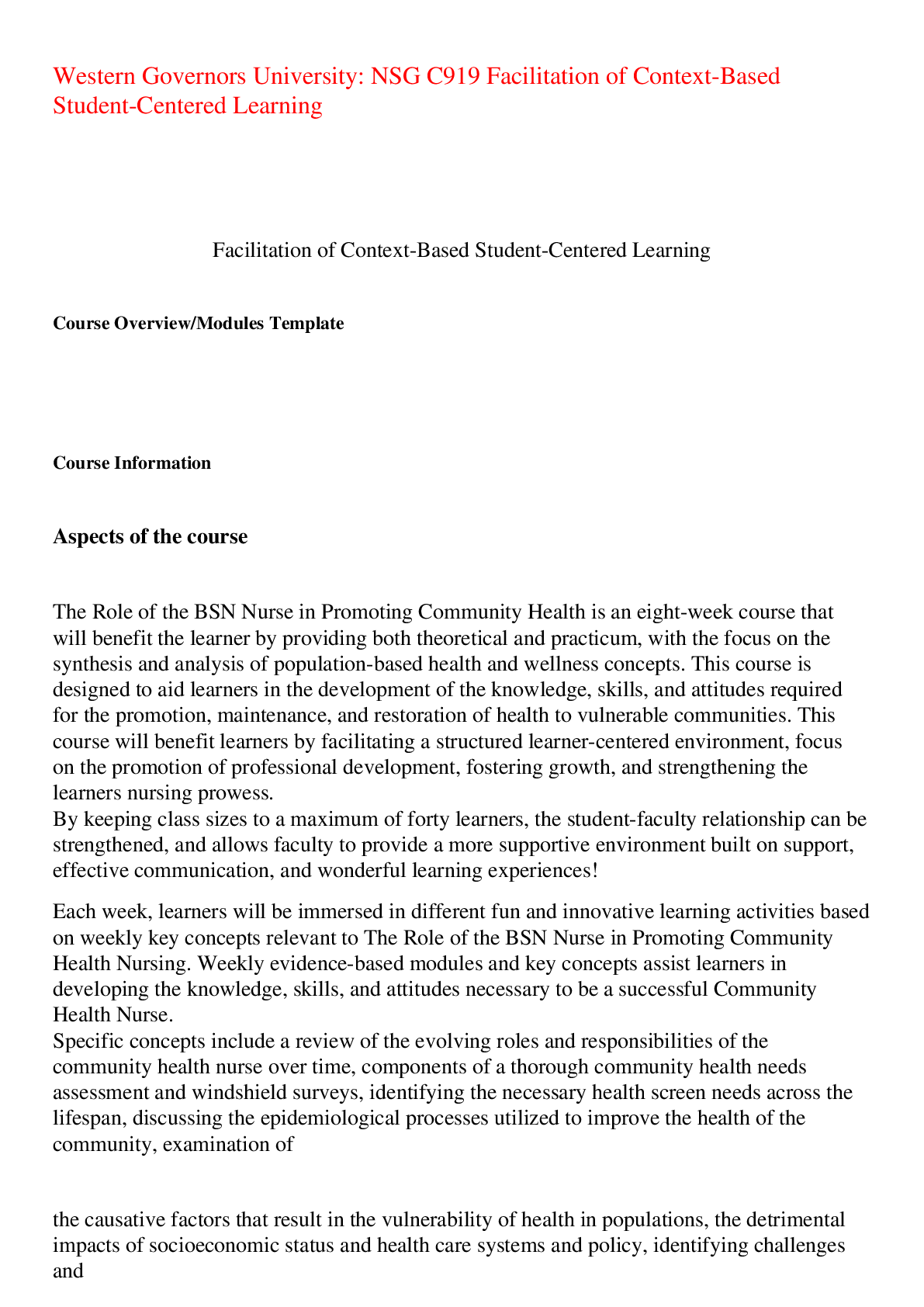
Buy this document to get the full access instantly
Instant Download Access after purchase
Buy NowInstant download
We Accept:

Reviews( 0 )
$12.00
Can't find what you want? Try our AI powered Search
Document information
Connected school, study & course
About the document
Uploaded On
Apr 02, 2023
Number of pages
15
Written in
Additional information
This document has been written for:
Uploaded
Apr 02, 2023
Downloads
0
Views
67


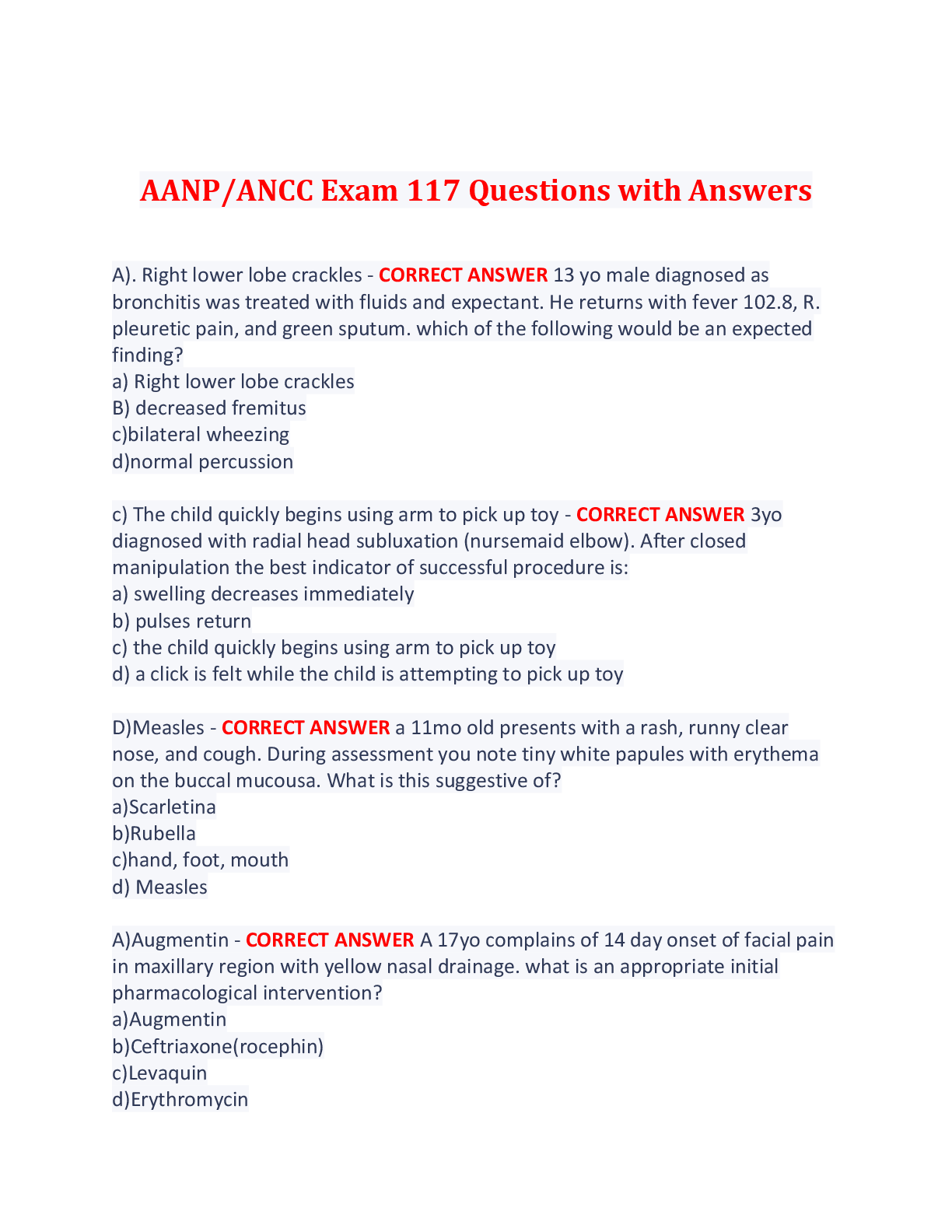

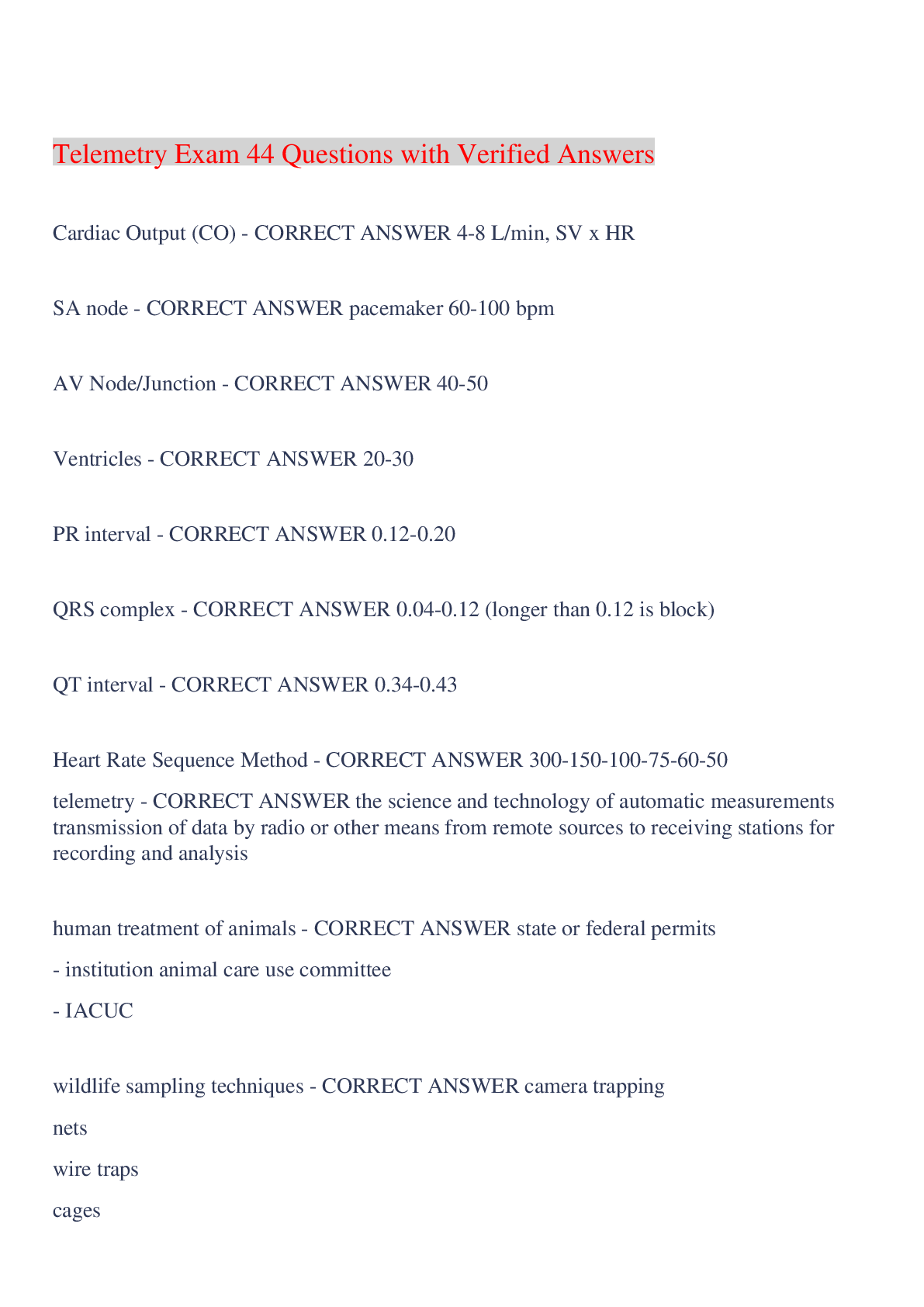
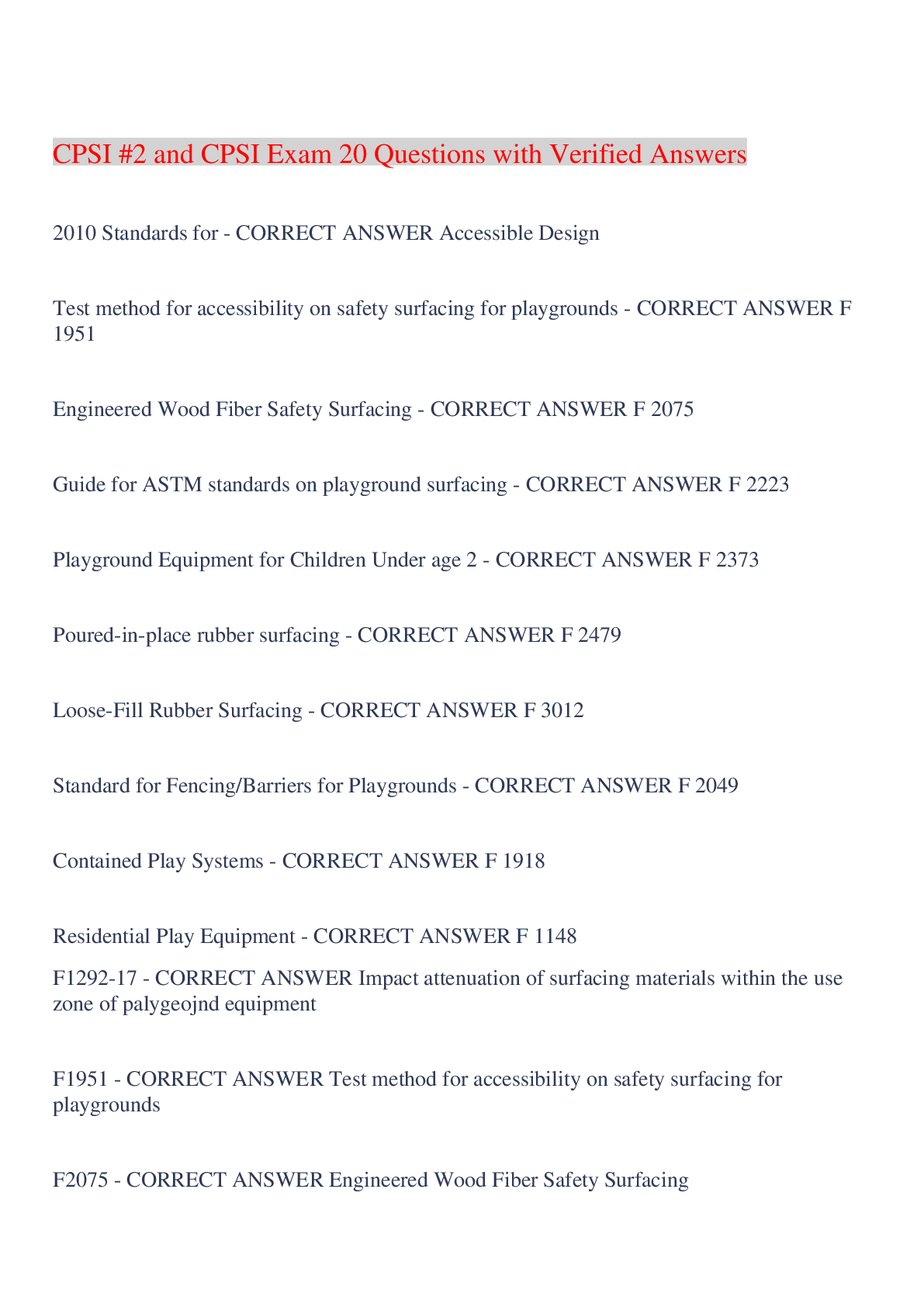
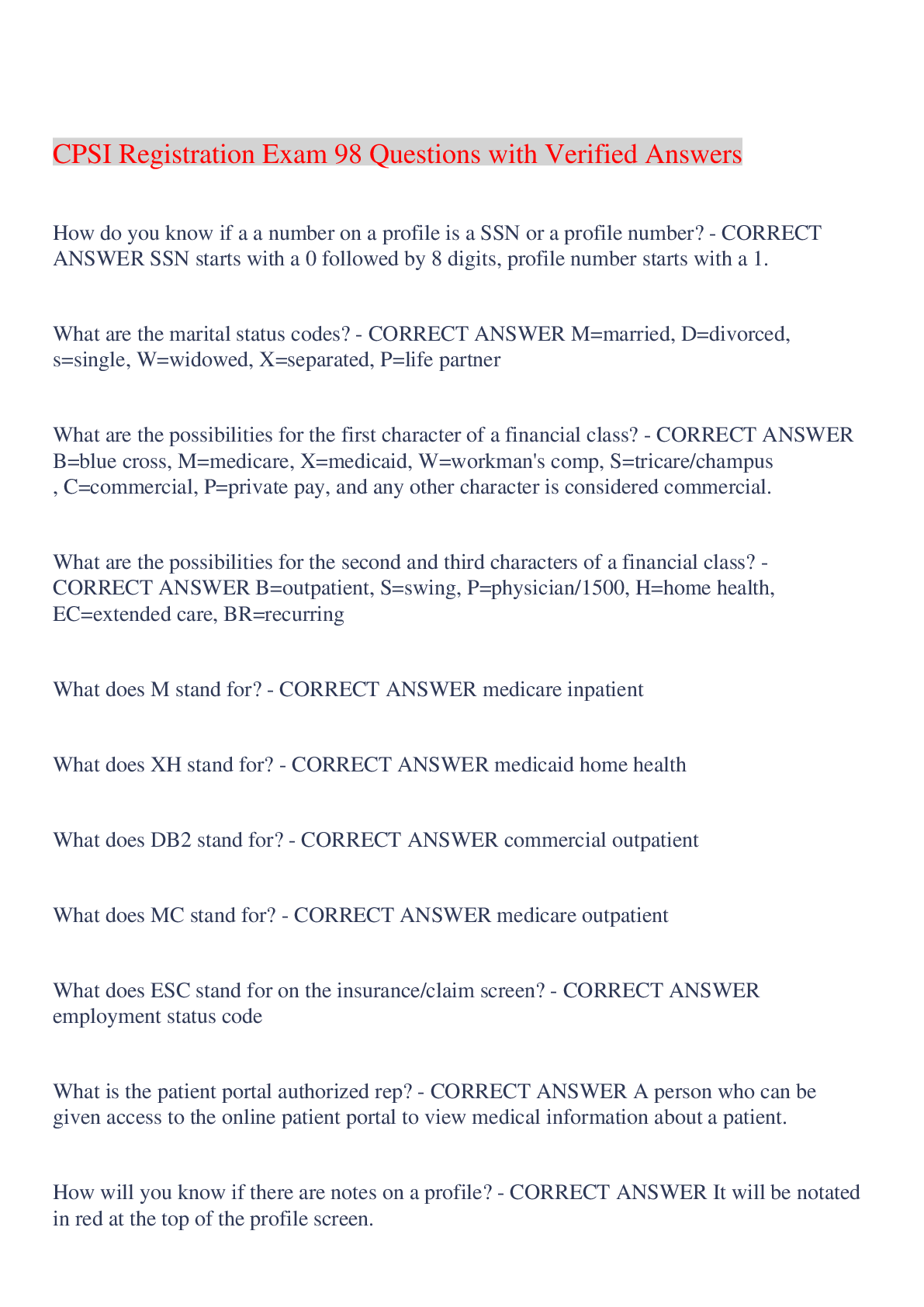
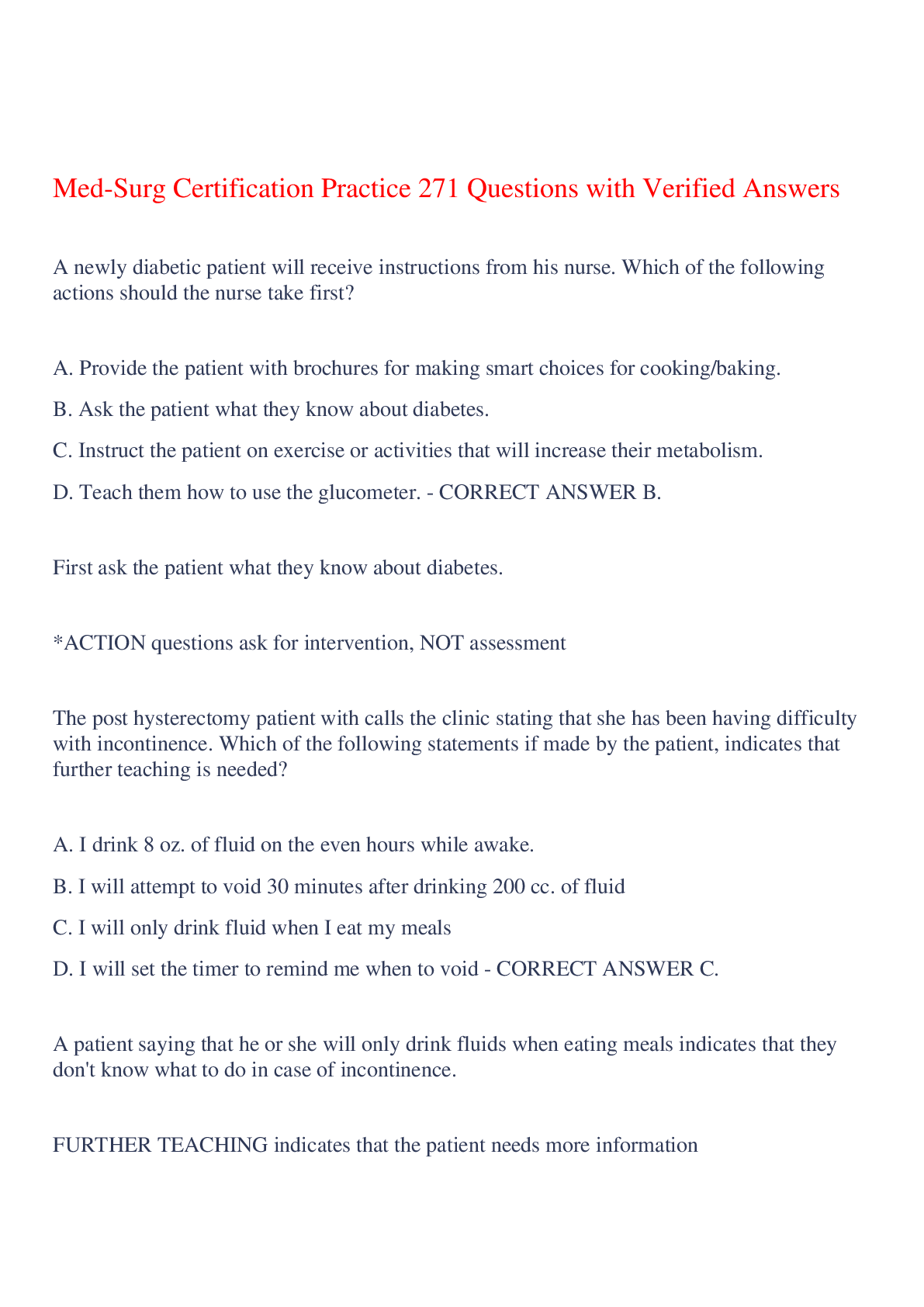



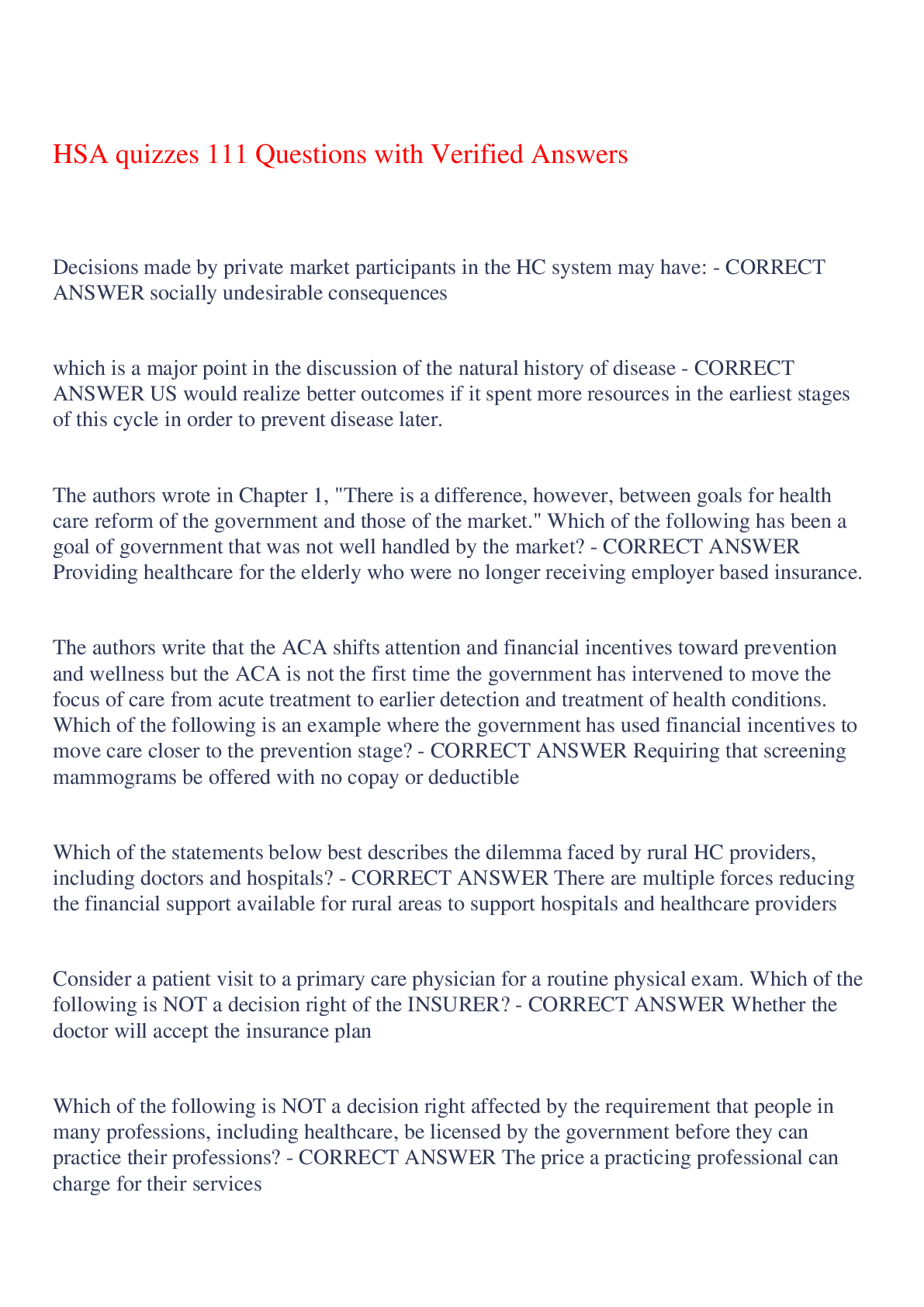
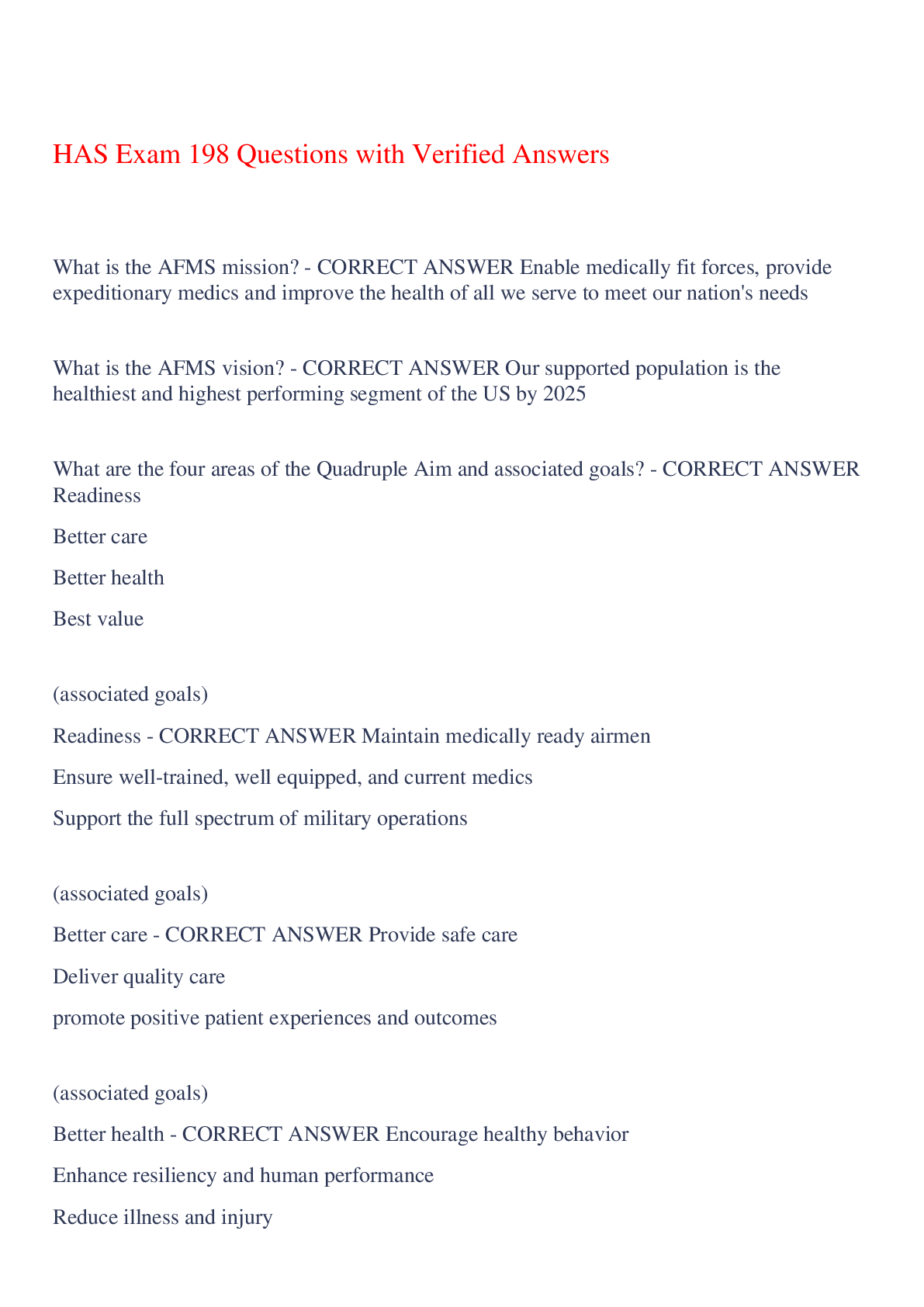
-Facilitation of Context-Based Student-Centered Learning.png)
